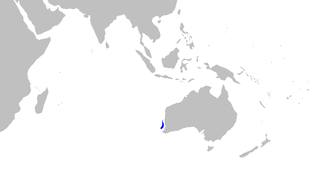
Carpet sharks are sharks classified in the order Orectolobiformes. Sometimes the common name "carpet shark" is used interchangeably with "wobbegong", which is the common name of sharks in the family Orectolobidae. Carpet sharks have five gill slits, two spineless dorsal fins, and a small mouth that does not extend past the eyes. Many species have barbels.

Cercidiphyllum is a genus containing two species of plants, both commonly called katsura. They are the sole members of the monotypic family Cercidiphyllaceae. The genus is native to Japan and China and unrelated to Cercis (redbuds).

The Hemiscylliidae are a family of sharks in the order Orectolobiformes, commonly known as longtail carpet sharks and sometimes as bamboo sharks. They are found in shallow waters of the tropical Indo-Pacific.

The blind shark is one of two species of carpet sharks in the family Brachaeluridae, along with the bluegrey carpetshark. Found along the coast of eastern Australia, this nocturnal, bottom-dwelling species is common in rocky areas and seagrass beds from the intertidal zone to a depth of 140 m (460 ft). It often roams in tidal pools where it may be trapped by the receding tide, and can survive for an extended period out of water.

The bluegrey carpetshark or Colclough's shark, is an uncommon species of carpet shark endemic to shallow inshore waters off northeastern Australia. It is one of the two extant members of the family Brachaeluridae. The bluegrey carpetshark has a stocky body with a wide, slightly flattened head, dorsally placed eyes, and a pair of long barbels with posterior skin flaps. It has large pectoral fins, two dorsal fins of unequal size placed far back on the body, and a sizeable space between the anal fin and the base of the caudal fin. Growing to 76 cm (30 in) long, this species has a black-and-white colour pattern as a juvenile, which largely fades with age such as that adults are brownish.

Brachaelurus is the sole genus of sharks in the family Brachaeluridae in the order Orectolobiformes. Only two extant species of blind sharks occur, both of which are native to shallow coastal waters up to 110 m (360 ft) deep, off the eastern coast of Australia.

The barbelthroat carpetshark is a carpetshark of the family Parascylliidae found in the South China Sea between Luzon in the Philippines and China, between latitudes 23°N and 10°N, at depths between 180 and 190 m. Its length is up to 34 cm.

The Taiwan saddled carpetshark is a carpetshark of the family Parascylliidae found around Taiwan, between latitudes 28°N and 21°N, at depths to 110 m. Its length is up to 39 cm.

The saddle carpetshark is a carpet shark of the family Parascylliidae found around Japan, between latitudes 35°N and 24°N, at depths between 250 and 290 m. The saddle carpetshark is known to grow up to 49 cm (19 in) in length, and it is an oviparous.

The rusty carpetshark is a carpetshark of the family Parascylliidae found off southern Australia between latitudes 31°S and 41°S near the ocean floor on the continental shelf. It inhabits rocky reefs and seagrass beds 5–150 m (16–492 ft) in depth by night, hiding in caves by day. Its length is up to 80 cm (2.6 ft) TL and it feeds on crustaceans and molluscs. Reproduction is oviparous, with pups being born at 17 cm (6.7 in) in length.

The collared carpetshark is a poorly understood species of carpetshark of the family Parascylliidae endemic to the waters of eastern Australia between latitudes 26°S and 38°S. It is typically found 55–128 m (180–420 ft) in depth near the floor of rocky reefs on the continental shelf, though its depth range can extend between 20 and 230 m. At a maximum length of only 85 cm (2.79 ft), it poses no threat to humans. It is common within its range and is not targeted species. This, combined with high survival rates after discardment and a significant portion of habitat untouched by fishing are why it is listed as Least Concern by the International Union for Conservation of Nature (IUCN). Reproduction is oviparous and embryos feed solely on yolk.

The ginger carpetshark is a species of carpetshark of the family Parascylliidae endemic to the waters of western Australia. It is a small fish at only 78.1 cm (2.56 ft) TL in length in females and harmless to humans. Its depth range is 204–245 m (669–804 ft) on the upper continental shelf. It is known from only three specimens, so biological and population data are lacking. It is likely not under threat due to its depth range, but its limited range may make it vulnerable to fishing. Reproduction is oviparous and embryos feed solely on yolk.

The necklace carpetshark, also known as the varied carpetshark, is a carpetshark of the family Parascylliidae endemic to the waters off Australia's southern coast between latitudes 37°S and 41°S. It is found near the ocean floor over sand, rock, coral reefs, and kelp and seagrass beds at depths down to 180 m (590 ft). It is almost exclusively seen at night and spends the day hidden in caves or camouflaged on the ocean floor.

The Arabian carpetshark is a species of carpet shark in the family Hemiscylliidae, inhabiting coral reefs and other shallow coastal habitats from the Persian Gulf to India. Reaching 78 cm (31 in) long, this shark is characterized by a slender, plain brown body, and by two dorsal fins with straight trailing margins and the second smaller but longer-based than the first. The Arabian carpetshark feeds on bony fishes and invertebrates. Reproduction is oviparous with an annual cycle; females deposit egg capsules four at a time and the young hatch after 70–80 days. This small shark is often captured as bycatch but rarely used by humans. It has been assessed as Near Threatened by the International Union for Conservation of Nature (IUCN), as there is increasing fishing pressure and habitat degradation within its range. It does well in aquariums and has been bred in captivity.

Parascyllium is a genus of carpetsharks in the family Parascylliidae. Species in this genus are distributed in waters around Australia.

Hemiscyllium is a genus of sharks in the family Hemiscylliidae.

The leopard epaulette shark, also known as the Milne Bay epaulette shark and Michael's epaulette shark, is a species of bamboo shark in the genus Hemiscyllium. It is a tropical shark known from the shallow ocean in the Milne Bay region of eastern Papua New Guinea. The epaulette sharks of this region have long been confused with the Indonesian speckled carpetshark, and it was only in 2010 that H. michaeli was described as a separate species by Gerald R. Allen and Christine L. Dudgeon. It can reach a maximum length of 82 cm (32.3 in). Confusingly, some books with illustrations and photos labelled as H. freycineti actually show H. michaeli.
The elongate carpet shark is a species of carpetshark in the family Parascylliidae. It is known from a single female specimen 42.1 cm (16.6 in) long, recovered from the stomach of a school shark caught from a depth of 50 m (160 ft) off Chatham Island, Western Australia. It was described by P.R. Last and J.D. Stevens in 2008.

















